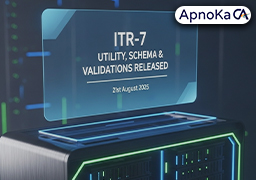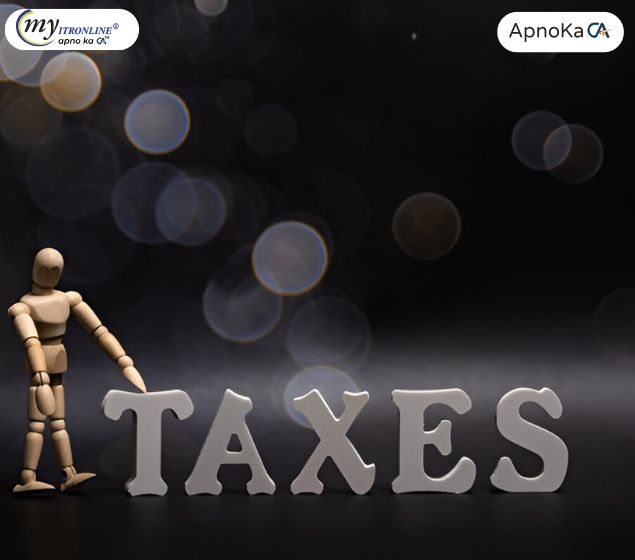# apnokaca
12 posts in `apnokaca` tag

Complete Guide to ITR-7 Form (AY 2025-26): Utility, Schema & Validation
The Income Tax Department has released the ITR-7 Form for AY 2025-26, applicable to persons and institutions required to file returns under sections 139(4A), 139(4B), 139(4C), and 139(4D). This blog covers the newly released Excel-based utility, JSON schema, and validation guidelines to simplify your tax filing process.
.jpg)
Income Tax Depreciation Rates for FY 2025-26 (AY 2026-27): The Complete Guide
A comprehensive guide for businesses on the depreciation rates and rules applicable for the Financial Year 2025-26 under the Indian Income Tax Act. The blog details the core principles, including the 'Block of Assets' concept and the WDV method. It provides a clear breakdown of depreciation rates for various asset classes like buildings, machinery, and intangible assets. Furthermore, it covers crucial special provisions such as additional depreciation for manufacturing units, rules for the sale of assets, and recent updates like the non-depreciable status of goodwill, empowering businesses with the knowledge for effective tax planning and compliance.
.jpg)
Good News for Taxpayers: Delayed Income Tax Refunds Are Finally Being Released
The long wait for delayed income tax refunds is finally coming to an end! The Income Tax Department has taken steps to clear pending refunds by resolving portal glitches, verifying returns faster, and processing lakhs of refunds worth crores of ₹ daily. Learn why refunds were delayed, what’s being done now, and follow a simple checklist to make sure your refund reaches your bank account without further delay.
.jpg)
Sold Property in FY 2024–25: Know Tax Rates & Exemptions under Sections 54, 54EC, 54F
A simplified guide for individuals who sold property in FY 2024-25, explaining the tax rates on short-term and long-term capital gains and detailing how to save tax by reinvesting under Sections 54, 54EC, and 54F of the Income Tax Act.
.jpg)
AY 2025-26 ITR Filings Cross 3.29 Crore; Over 1.13 Crore Already Processed
Despite the ITR filing deadline for AY 2025-26 being extended to September 15, over 3.29 crore returns have already been filed by mid-August, with 1.13 crore processed. This highlights growing tax compliance and the Income Tax Department's processing efficiency.

CBDT Raises Tax-Free Benefit Limits: Relief for Salaried Employees with Incomes up to 8 Lakh
The Central Board of Direct Taxes (CBDT) has introduced new rules, 3C and 3D, effective August 18, 2025, which raise the income thresholds to 4 lakh (salary) and ₹8 lakh (gross total income) for taxing specific perquisites. This move provides significant tax relief on non-cash benefits for middle-income salaried employees.
.jpg)
CBDT Updates Form No. 7: Assessment Year and Block Period Now Included, Effective September 1, 2025
The Central Board of Direct Taxes (CBDT) has amended Form No. 7 to include both "Assessment Year" and "Block Period," effective September 1, 2025. This blog details the changes, explains the concept of a "Block Period" in tax assessments, and discusses the implications for taxpayers, particularly in cases of search and seizure operations.
.jpg)
4 Major Income Tax Changes for FY 2025-26 You Need to Know
This blog provides a detailed overview of four significant amendments to the Income Tax Act effective from Financial Year 2025-26. It covers the establishment of the new tax regime as the default option for taxpayers, the mandatory timely payments to MSMEs under the new Section 43B(h), the extension of tax benefits for startups, and the revised rules and thresholds for Tax Collected at Source (TCS) on foreign remittances and luxury goods.

ITR-6 Excel Utility for AY 2025-26 is Live: What Corporate Filers Need to Know
This blog announces the release of the ITR-6 Excel Utility for the Assessment Year 2025-26 by the Income Tax Department. It details which companies are required to file this form, highlights key updates and changes for this year (such as LEI and capital gains reporting), provides a step-by-step guide on how to use the offline utility, and clarifies the important filing deadlines to help corporate filers ensure timely and accurate compliance.
.jpg)
Navigating the Crypto Tax Minefield: A Detailed Guide for India's FY 2025-26
This blog provides a comprehensive guide to the taxation of Virtual Digital Assets (VDAs) and cryptocurrencies in India for the Financial Year 2025-26. It details the prevailing rules, including the flat 30% tax on all profits, the stringent policy of no loss set-off or carry forward, and the mandatory 1% TDS on transactions. The article also covers the tax implications for gifts, airdrops, and staking, along with the mandatory ITR filing requirements, to help Indian investors and traders navigate the tax landscape and ensure full compliance.
.jpg)
Lost Your Form 16? Don't Panic! Here's How to File Your ITR Successfully Without It.
This comprehensive guide addresses the common concern of a missing Form 16. It empowers salaried individuals to confidently file their Income Tax Return by detailing essential alternative documents (pay slips, Form 26AS, AIS) and providing a clear, step-by-step process for successful and compliant ITR filing, ensuring no one misses the deadline due to a lost document.
.jpg)
Oops! Did You Make an ITR Mistake? Here's How to Easily File a Revised Return
Made an error on your Income Tax Return? Don't stress! This comprehensive guide walks you through the process of filing a Revised Return under Section 139(5) for Assessment Year 2025-26. Learn common reasons for revision, key deadlines, and a simple step-by-step online process to ensure your tax records are accurate and penalty-free.
